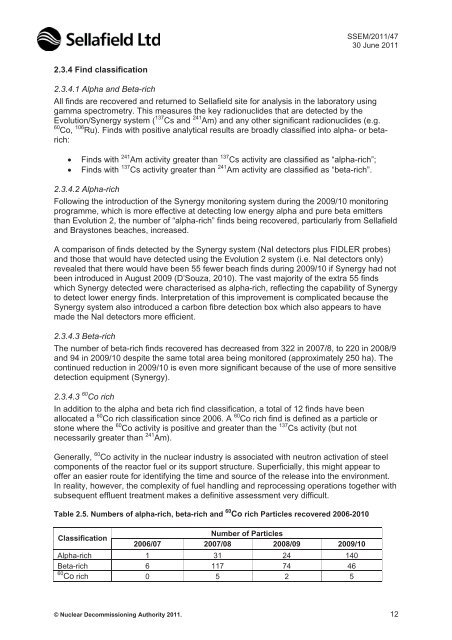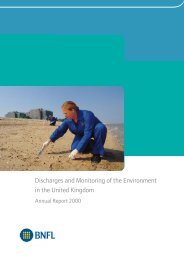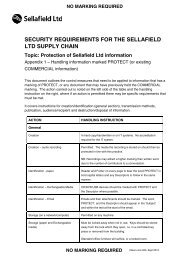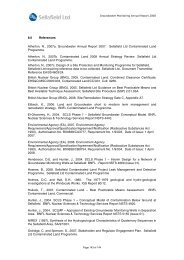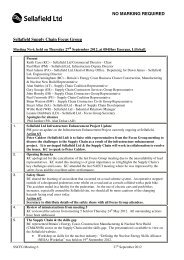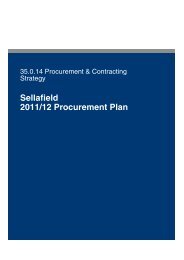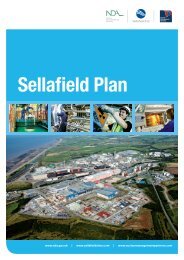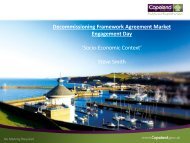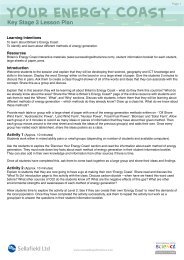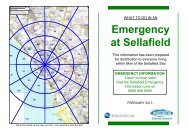Annual Report for 2010/11 and Forward Programme - Sellafield Ltd
Annual Report for 2010/11 and Forward Programme - Sellafield Ltd
Annual Report for 2010/11 and Forward Programme - Sellafield Ltd
You also want an ePaper? Increase the reach of your titles
YUMPU automatically turns print PDFs into web optimized ePapers that Google loves.
SSEM/20<strong>11</strong>/4730 June 20<strong>11</strong>2.3.4 Find classificationAll finds are recovered <strong>and</strong> returned to <strong>Sellafield</strong> site <strong>for</strong> analysis in the laboratory usinggamma spectrometry. This measures the key radionuclides that are detected by theEvolution/Synergy system ( 137 Cs <strong>and</strong> 241 Am) <strong>and</strong> any other significant radionuclides (e.g.60 Co, 106 Ru). Finds with positive analytical results are broadly classified into alpha- or betarich:Finds with 241 Am activity greater than 137 Cs activity are classified as “alpha-rich”;Finds with 137 Cs activity greater than 241 Am activity are classified as “beta-rich”.Following the introduction of the Synergy monitoring system during the 2009/10 monitoringprogramme, which is more effective at detecting low energy alpha <strong>and</strong> pure beta emittersthan Evolution 2, the number of “alpha-rich” finds being recovered, particularly from <strong>Sellafield</strong><strong>and</strong> Braystones beaches, increased.A comparison of finds detected by the Synergy system (NaI detectors plus FIDLER probes)<strong>and</strong> those that would have detected using the Evolution 2 system (i.e. NaI detectors only)revealed that there would have been 55 fewer beach finds during 2009/10 if Synergy had notbeen introduced in August 2009 (D’Souza, <strong>2010</strong>). The vast majority of the extra 55 findswhich Synergy detected were characterised as alpha-rich, reflecting the capability of Synergyto detect lower energy finds. Interpretation of this improvement is complicated because theSynergy system also introduced a carbon fibre detection box which also appears to havemade the NaI detectors more efficient.The number of beta-rich finds recovered has decreased from 322 in 2007/8, to 220 in 2008/9<strong>and</strong> 94 in 2009/10 despite the same total area being monitored (approximately 250 ha). Thecontinued reduction in 2009/10 is even more significant because of the use of more sensitivedetection equipment (Synergy). In addition to the alpha <strong>and</strong> beta rich find classification, a total of 12 finds have beenallocated a 60 Co rich classification since 2006. A 60 Co rich find is defined as a particle orstone where the 60 Co activity is positive <strong>and</strong> greater than the 137 Cs activity (but notnecessarily greater than 241 Am).Generally, 60 Co activity in the nuclear industry is associated with neutron activation of steelcomponents of the reactor fuel or its support structure. Superficially, this might appear tooffer an easier route <strong>for</strong> identifying the time <strong>and</strong> source of the release into the environment.In reality, however, the complexity of fuel h<strong>and</strong>ling <strong>and</strong> reprocessing operations together withsubsequent effluent treatment makes a definitive assessment very difficult.Table 2.5. Numbers of alpha-rich, beta-rich <strong>and</strong> 60 Co rich Particles recovered 2006-<strong>2010</strong>ClassificationNumber of Particles2006/07 2007/08 2008/09 2009/10Alpha-rich 1 31 24 140Beta-rich 6 <strong>11</strong>7 74 4660 Co rich 0 5 2 5© Nuclear Decommissioning Authority 20<strong>11</strong>. 12


